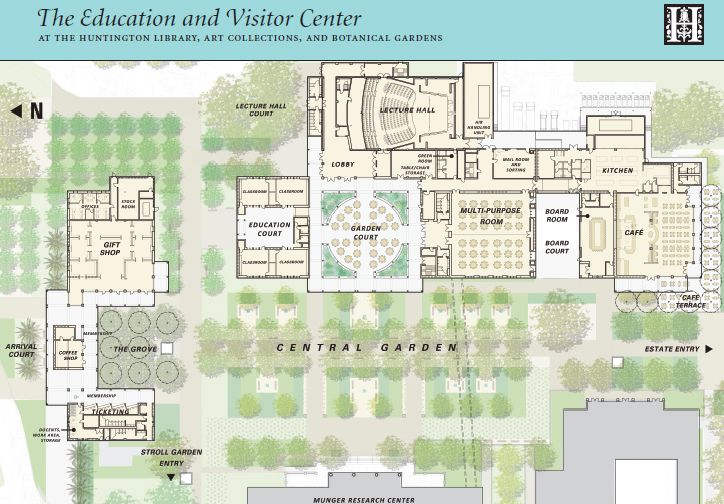
On the 14th of this month I attended a lecture by Huntington Botanical Gardens head gardener Seth Baker entitled “The 4D Garden; Landscape Design Using Form, Color, Texture, and Time.” If I understood correctly, it was his first such public lecture after 13 years with the Huntington, so it may have been more than slightly daunting to face all of us filling every last seat in the Ahmanson auditorium, eager to access his thoughts on the making of the new entry garden which debuted in 2015. It’s a rare plantsperson that is able to transition from the state of rapturous, solitary absorption in plants that makes up most of a day to enthusiastic communicator of design intentions and ideas. Mr. Baker did just fine. It was fascinating to learn of the sausage-making decisions that went into a result that looks perfectly scaled, serene and inevitable. It was too dark in the auditorium for much note-taking, and a copy of the outline of the lecture was not available. I’m adding photos I’ve taken over several visits,* which are unfortunately mostly close-ups of the plantings and not the overall design, and don’t have photos of other areas he addressed, like the Stroll Garden where the Calder sculpture is located, and the entrance on Oxford Road, which is having the planting redone to minimize/hide utilitarian functions like the loading dock (what Mr. Baker characterizes as looking like the “back of a Costco.”) Mexican Fence Post cactus is part of the new planting being added along Oxford Road.

Even now minor controversies and differing opinions continue over the Central Garden. Mr. Baker feels that mirror-image planting on either side of the rill may inadvertently deter visitors from walking both sides, so he’d love to bring in some asymmetry to the planting to encourage further exploration.
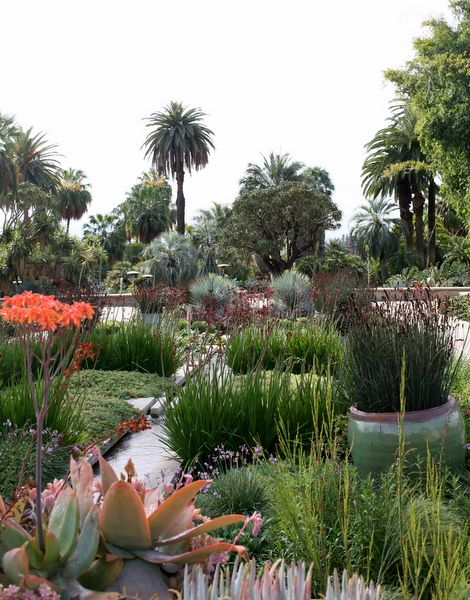
A Persian carpet has been the general inspiration for the planting along the rill, and he’d like to take the concept even further, producing several slides of various designs abstracting out that concept. Mr. Baker also referenced the ad-hoc barriers erected at intervals down the length of the rill to keep guests from walking down the center. He’s not a fan of the barriers, and finally encouraged security to take them down for a day. Now that the planting has filled in, he reasoned, surely people would understand that it’s a design feature only. On the contrary, surely not! Eager feet flooded the rill and chaos ensued, which made security staff very unhappy, and the barriers are back in place as stern visual guides.

It’s astonishing how in just three years the strongly linear bones of the Central Garden are now fully animated by the lush growth of plants. An early concept that was abandoned involved organizing the Central Garden by grouping plants according to the five mediterranean zones: California; Central Chile; the Mediterranean Basin; the Cape Region of South Africa; and Southwestern and South Australia. Now plants freely intermingle, regardless of origin, as long as they can claim mediterranean, relatively summer-dry bonafides.

As we’ve all discovered, the varying tolerances to summer irrigation by some California natives makes their inclusion tricky, while other mediterranean plants suffer under too infrequent irrigation. Watching many plant treasures fail to thrive, Mr. Baker says he’s come to appreciate the steadiness and reliability of classics like rosemary. An audience member asked about the health of Phyllica pubescens, the featherhead shrub from South Africa, and Mr. Baker said it was probably time to turn off the drip irrigation to it. Collapse of mediterranean shrubs in summer from water mold issues is an ongoing consideration. (I checked out the phyllica later in the afternoon, and it looked fine to me.)

Big drifts of California sages seem to be flourishing, seen here with verbascum.

Off the central axis/allée, the “hedged rooms,” as Mr. Baker refers to them, framed in rich green myrtle, look mature beyond their three years of age. The curry plant, Helichrysum italicum, sprawls in the foreground of this hedged room.
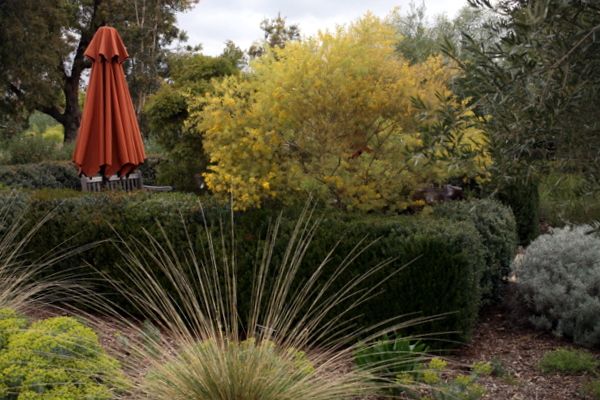
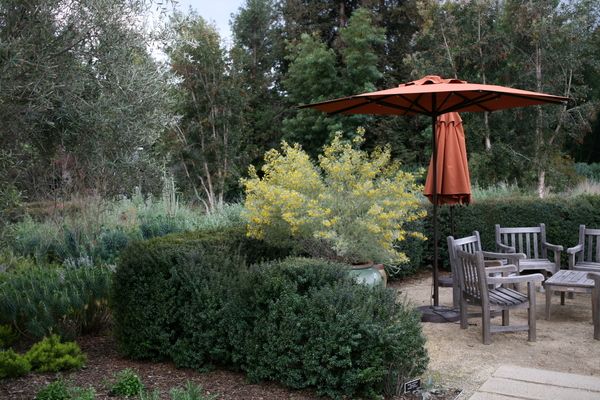
Acacias, leucadendrons, aloes, bunch grasses, euphorbias and potted shrubs like this senna are also thriving.


The Munger Research Center, just visible in the distance, is closed to the general public, but its important, courthouse-like appearance draws many curious visitors up its steps, only to be turned away at the door. Even though such an experience is arguably a minor disappointment at most, various landscape design schemes are being contemplated to clarify the building’s use to the public without seeming exclusionary.

Another potentially confusing feature was this narrow lawn off the Munger, ending in a dead-end wall.

The Huntington’s deep-pocket storehouse of antiquarian urns comes to the rescue as a focal point, lending purpose to the closed-off space.
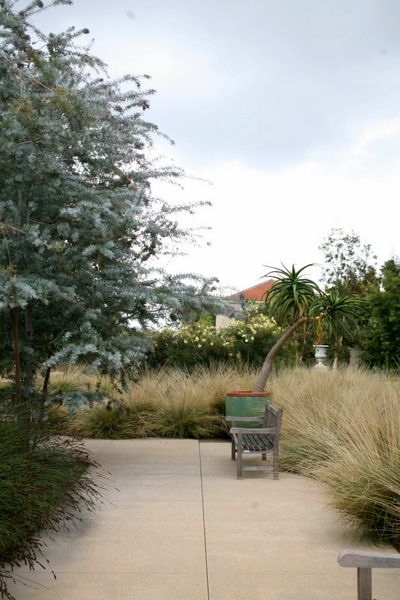
The same urn in the distance. I believe this area will eventually be reworked with paths communicating into the Central Garden. Getting the pedestrian flow just right has been an all-consuming process.
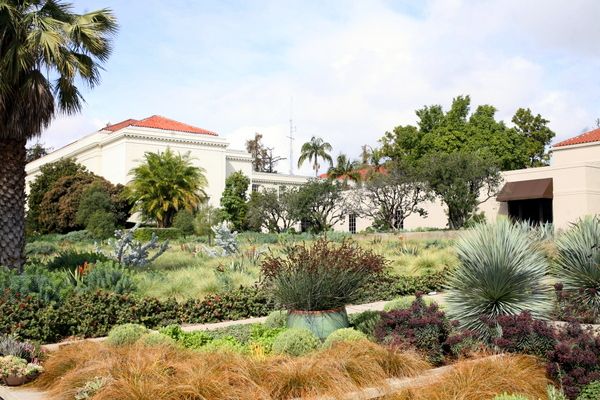
One of Mr. Baker’s favorite bits of planting is this simple meadow at the end of the Central Garden leading into entry to the rest of the estate, with the library in the distance.
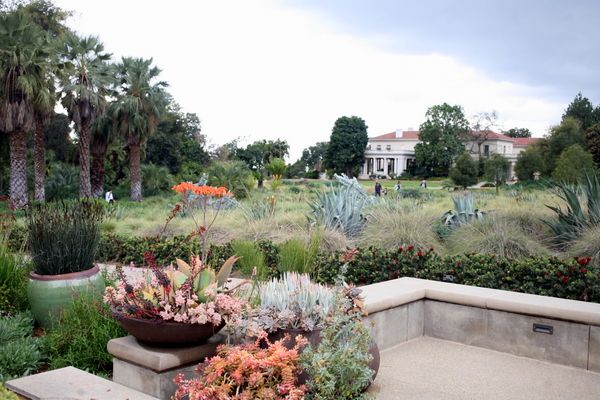
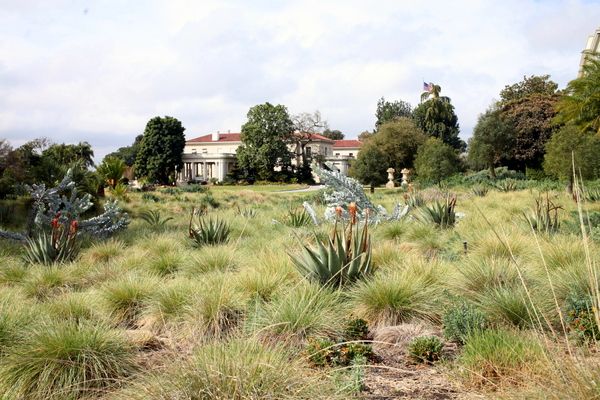
Agaves, bunch grasses and Aloe ferox, with silvery shrub Leucadendron argenteum interspersed.

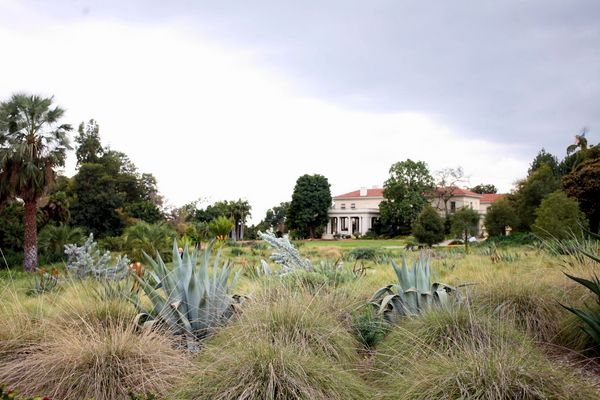
Mr. Baker is a graduate of the ArtCenter in Pasadena, with a Bachelor’s in Environmental Design, but he also credited his childhood in Bishop, California, at the base of the Eastern Sierras, as critically formative in developing his sense of monumental scale, tension and release in the landscape. For further reading, he suggested “Form & Fabric in Landscape Architecture,” by Catherine Dee, as especially useful.
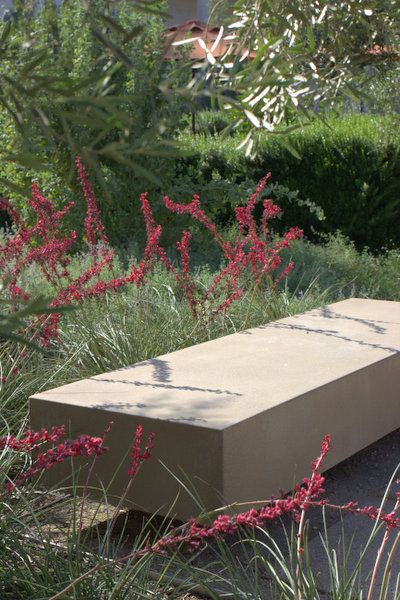
A short interview with Mr. Baker can be found on the Huntington’s blog Verso here.
*I’ve pulled in photos from several visits, in all seasons and all weather, to illustrate components of the design.

I love the Central Garden. It’s the one area of The Huntington I always make a point of visiting and photographing. Thanks for sharing the back story of its creation.
Beautiful photos and interesting accompanying text. I can’t wait to visit again soon, as I have not seen the “new” entry garden.
And I’m sorry but what? People are walking down the center rill? WTF???
HoovB wrote early on about those barriers that cut across the rill, but I had gotten it into my head that they were intended and designed to invite visitors to walk *across* the rill. I regret to hear that that Baker is thinking of messing with the symmetry of the planting there, which is a big part of its appeal. Persian carpets are symmetrical, and one of the reasons is that it helps the viewer handle the intricacy of the patterns. Also, you’d think the opening-up debacle would have reduced his enthusiasm for visitor “exploration” — and it’s not as if the extensive entry garden lacks other areas and plantings to draw them through.
For example, that broad boulevard with grey-green plantings and the big containers with splashes of warm color. That image makes me long to step into the picture and stroll awhile.
Very glad they ditched the idea to “[group] plants according to the five mediterranean zones: California; Central Chile; the Mediterranean Basin; the Cape Region of South Africa; and Southwestern and South Australia.” That’s done beautifully at S.F. Botanical Garden (formerly Strybing Arboretum), where the available space and the gentler coastal climate are more favorable for success.
The antiquarian urn (and its strip of lawn) are at war with the rest of the garden, which shows most clearly in the photo where the urn’s seen at a distance. Maybe they’ll go in the opening-up of that space, or be more visually separated in the re-do around the Munger.
Design and planting on this kind of scale is fascinating, as the attendance at the talk demonstrates. Thanks so much for the report-back, and the images that illustrate the main points as well as being gorgeous in their own right.
Really wanted to attend this lecture, but life intervened. Thrilled to have this articulate summary. Regarding the symmetry of the rill garden, think disrupting the harmony would be a mistake. If the influence is indeed Islamic gardens (and visual culture more broadly), this sense of balance and symmetry is essential. Either way, this is such a monumentally successful garden.
Good point that designers of public spaces must think about things that home gardeners need not attend to: traffic flow, building access for employees but not visitors, unused spaces with dead ends, and the like.
Methinks the symmetry of the rill is fine–my reasoning is: there’s so much to look at as it is anyway. One can only absorb so much in this complex modern world. More seems like too much. The asymmetry of the entry garden vs. the symmetry of the rill is also a form of transition from one place to another–the rill while spectacular is also the transition point from entry to the Huntington proper.
I like that grassy meadow punctuated by Agaves off to the west also–though perhaps the silvery beastie is not Leucadenron argenteum but rather Eucalyptus macrocarpa?
@Kris, this was a lecture I didn’t want to miss, since the entry garden was such a massive undertaking.
@Loree, people “do” people — nuff said!
@Nell, the consensus seems to be to leave the rill symmetrical. Like many of us, Seth seems reluctant to miss opportunities to try new plants 😉
@Jeremy, a mid-day, mid-week lecture is indeed difficult to find time for!
@Hoov, I don’t know where I got the idea the silver shrubs were those touchy leucadendrons, but their vigor does seem more in line with a eucalyptus — probably a lot easier to get established. Might be a better choice as a mallee eucalyptus than ‘Moon Lagoon,’ which needs a lot of intervention to retain the blue juvenile leaves. The ML’s are nearly unrecognizable now in the entry garden near the hedged rooms — a nice rusty color to the leaves but formless.
I can get behind that scene of the grasses and agaves, of course. It reminds me of NM’s desert grassland uplands, with some California dotting it inside or on the edges. How his growing up in the powerful area of the Owens Valley (been there a few times) makes total sense on his scale and tension / release. It’s that way here, and it often informs the better landscapes around town.
It’s interesting how well your area has taken to Hesperaloe p. ‘Brakelights”! My 1/2014 trip to the Huntington will need to be repeated soon with that entry garden plan.